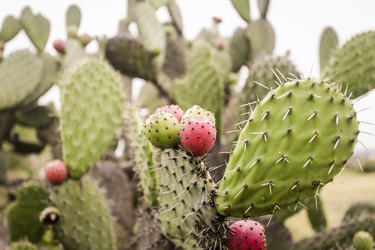The prickly pear (Opuntia spp.), also known as nopal, is a cactus you can eat as a vegetable in a variety of dishes, or you can use the fruits as a beverage, jelly or candy. Hardy in U.S. Department of Agriculture plant hardiness zones 3 through 9, the edible oval pads and fruits, called pencas or nopalitos and tuna, are also enjoyed by wildlife and livestock across the Americas, including the Caribbean and Galápagos Islands.

Video of the Day
Prickly Pear Cactus Species
With approximately 140 Opuntia species, there's a prickly pear for nearly every garden. Often used as a protective fence as well as a garden and landscape plant, prickly pears grow from less than 12 inches tall to 16 feet or more.
Video of the Day
Prickly pears sport spines as well as minute, barbed "hairs" called glochids on their stems. Depending on the species, the plant may grow round stems with flattened pads, or the paddle-shaped pads form the stem segments. The spines are actually the modified "leaves" of the plant, developed to protect against browsing herbivores. The fleshy round fruits appear after the cactus produces its flowers along the upper edges of the pads.
Humans Enjoy the Pads and Fruits
Prickly pear has been harvested for centuries by the indigenous peoples of North, Central and South America as well as the islands of the Caribbean and Galapagos. The spines and glochids on the leaves are carefully removed or burnt off and then cut up and used raw in salads or sauteed, steamed, stewed or pickled for use in a variety of dishes, including scrambled eggs.
The fruits are used fresh in salads and fruit salsas, while the juice is made into a beverage, syrup, jelly and candy. Like the pads, the glochids must be removed and then the fruits peeled to reach the juicy pulp inside. Crush and strain to remove the seeds when processing. Wear gloves, as the pulp and juice can stain your hands.
Livestock Will Eat Prickly Pear
While often ignored when other forage is available, cattle and other livestock will eat prickly pear when the spines are singed by propane burners or fire or when spineless species (Opuntia ficus-indica) are grown as fodder. In addition to cattle, goats and sheep will eat the pads and fruits, though they are sometimes affected by the spines, glochids and indigestible seeds.
Wildlife and Prickly Pear
Wildlife, from deer to peccaries to tortoises, depend on the prickly pear for both food and shelter. The spineless species and cultivars are vulnerable to rabbits and other herbivores, even in suburban landscapes and cities. Birds, including cactus wrens and Galapagos finches, eat the flower nectar, fruits and seeds and use the cacti for shelter. Numerous rodents and reptiles also use the plants for shelter.
Pests and Prickly Pears
Though prickly pears are not considered to have serious insect problems, cactus bugs and cactus borers can kill a cactus by sucking out the sap. Insecticidal soaps and oils will wipe out cactus bug nymphs, but adult cactus bugs may require harsher measures to save your cacti. Cactus bugs and the adult cactus borers, black longhorned beetles, can be plucked from amid the spines and pads with tongs.
Another pest, cochineal, is a scale insect that produces clumps of white cottony- or frothy-appearing masses on prickly pear cacti. When smashed, these scale insects produce the crimson red that was once used as a dye. Other scale insects also affect prickly pears. Apply an insecticide with a hose-end sprayer or remove the affected parts of the plant.
Use Caution With Prickly Pears
When trimming, harvesting or preparing the pads or fruits, use caution when handling all parts of the plant. While the large spines are an obvious danger, the tiny glochids can become imbedded in your hands. Wear gloves and safety glasses while removing the spines and outer skin before slicing or juicing to avoid puncture wounds and skin irritation.
- Missouri Botanical Garden: Opuntia Macrorhiza
- North Carolina Extension Gardener Plant Toolbox: Opuntia
- U.S. Forest Service: Prickly Pear (Opuntia Basilaris P. Mill.)
- San Diego Zoo Wildlife Alliance: Prickly Pear Cactus
- University of Arizona Cooperative Extension: Prickly Pear Cactus: Food of the Desert
- The Galápagos Finches: Prickly Pear Cactus
- Chinle Cactus & Succulent Society: Pests & Diseases